Ask John: What are the Scariest Anime?
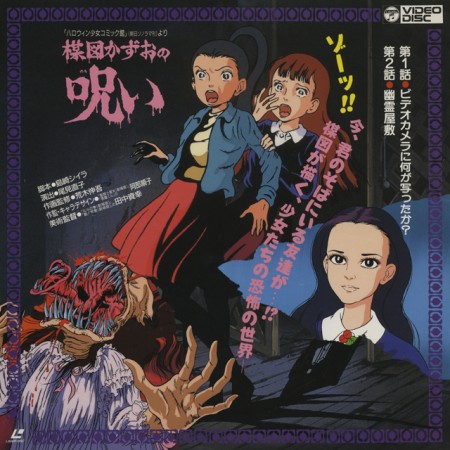
Question:
Since it is Halloween I figured I’d ask. What are the top scariest/spookiest animes you’d recommend?
Answer:
I feel as though I’m a little late to address this question, but since I didn’t receive it until after Halloween anyway, I suppose that the timing can be overlooked.
The two-dimensional illustrated nature of anime inherently distances it from reality and thus partially cripples its ability to evoke genuine fear. Viewers shrink in terror when they empathize with the characters, settings, and situations on screen. When watching anime, viewers are constantly aware that what they see isn’t real, thus the sense of personal peril is lessened. However, anime can still be unsettling and disturbing due largely to its narrative intensity. Japanese supernatural horror is quite unlike Occidental horror. Typical British and American ghost stories involve humans encountering and ultimately either exorcising or escaping supernatural manifestations. Westerners perceive spirits as terrifying and threatening but ultimately etherial, spectres that can be placated. In Japanese literature, however, the supernatural is more powerful than the human realm, and individuals targeted by ghosts are doomed. Unlike American horror that typically leaves room for possibility, Japanese horror is characterized by an implacable tragedy. In Japanese ghost stories there is no escape, no hope; those targeted by malicious spirits are doomed to death.
The sense of inescapable foreboding and shocking finality are oppressively prevelant in the 1990 Umezu Kazuo no Noroi and 1999 Inuki Kanako Zekkyou Collection: Gakkou ga Kowai! OVAs. Both of these disturbing anime shorts abound with creepy settings, unsettling art design, and most importantly, shocking tragic finality. Ironically, both OVAs are based on manga from artists best known for creating children’s stories. But the children that star in these OVAs don’t encounter cathartic happy endings. These two OVAs are grim, oppressive, creepy, and most shocking because they reject the typical positive endings expected of such anime. Viewers expect precocious young kids to escape unharmed, yet in these grim children’s horror OVAs, there are no happy endings, and no one gets out alive.
The 2000 Yonimo Osoroshii Grimm Douwa (Extremely Frightening Grimms Fairy Tales) OVA presents grotesque, morbid interpretations of the Hansel & Gretel, Bluebeard, and Cinderella fairy tales. While gore isn’t prevelant in the OVA, the unsettling art design of the Hansel & Gretel segment compounded by the perverse pessimism of the following two segments makes the entire OVA disturbing and unforgettable.
I have to admit that I only watched the first episode of 1991’s High School Mystery: Gakuen Nanafushigi television series many years ago, but my recollection of it is that unlike countless other “seven school mysteries” anime, Gakuen Nanafushigi maintains a foreboding and gloomy atmosphere throughout.
Again proving that many of Japan’s most creepy horror anime come from children’s authors, Ninja Hattori-kun, Pro Golfer Saru, and Doraemon creator Fujiko Fujio A’s 1989-1992 Warau Salesman (Laughing Salesman) anime series, based on the 1969–1971 manga, is deeply unsettling because it revels in exploiting and degrading typical human vices.
The 2000 Gakko no Kaidan television series has been severely compromised in America by its 2005 parody English dub from AD Vision. The series is frequently called “childish” or “dull,” but I wonder how much of that reaction is influenced by the skewed opinion of the American localization staff rather than reaction from viewers that have actually tried watching the original Japanese presentation. While not nearly as dark and morbid as the Gakkou ga Kowai OVA, viewers who actually try watching the original language version of the show may find that the Gakko no Kaidan TV series is actually a bit more spooky than it’s widely given credit for being.
In terms of unsettling narrative, the 1997 Vampire Miyu television series may surpass its predecessor OVA series because the TV series more appreciably illustrates Miyu’s cold aloofness to humanity. While Miyu does have close friends, she’s largely indifferent to average human beings, doing nothing to defend or protect them from supernatural harm.
The popular Higurashi no Naku Koro ni franchise suffers from an odd inversion. As the installments’ production values increase, the show becomes increasingly less about horror and more satirical and beholden to the prevelant moé marketing trend. Particularly the 2006 first TV series is horrifying and unsettling, provided that viewers can bear its shrill hyperbole and near parodical exaggeration.
I’d feel remiss if I didn’t at least mention a few other titles. The 2010 Shiki television series has its fans, but I don’t number among them. The show is ostensibly creepy, but it so lacks in plausibility and common sense that it’s impossible to take seriously, thus is comes across like a ridiculous parody of horror to me. Last year’s horror series Another has proven popular, but a highly pretentious and unfulfilling first episode discouraged me from watching more of it. The Corpse Party OVA franchise contains some intensely grotesque scenes but largely doesn’t maintain a frightening atmosphere.
Add a Comment
You must be logged in to post a comment.
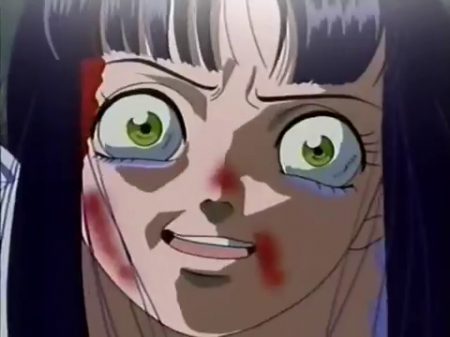
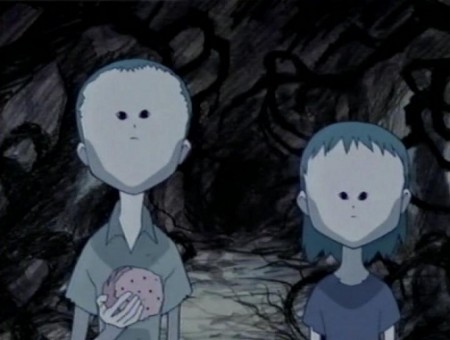
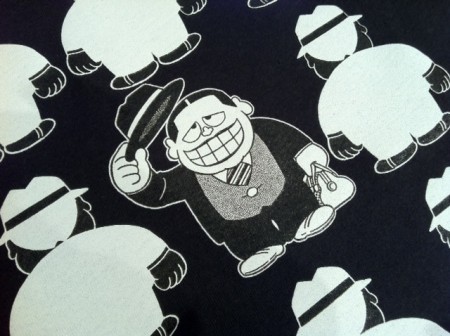
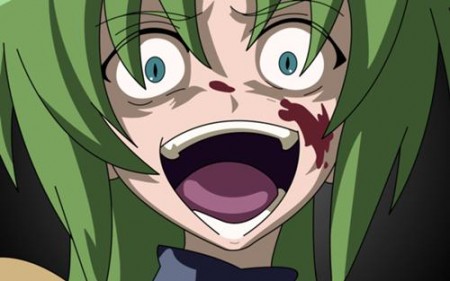


Masaaki Yuasa’s “Kemonozume” TV series has a pervasive and grotesque body horror element to it, though it’s not specifically a” horror” anime. (Sometimes it feels like a Terry Gilliam-esque surreal adventure.) Akitaro Daichi’s “Now and Then, Here and There” is memorably grim, a Joseph Kony -inspired anime series depicting a war machine that uses kidnapped children as soldiers, though again it is not specifically a horror genre work. Otherwise I agree that horror doesn’t play to the strengths of 2D animation.
Shin Sekai Yori is more of an ostensible horror anime. Its monster battles are often clumsy, but its enigmatic world and the way in which it’s gradually revealed is maddening. The more you learn, the more hours you’ll spend between episodes contemplating its doomed world, struggling to think of any escape for the characters who, through no fault of their own, continually walk into traps and set into motion their own demise.
I don’t count Shin Sekai Yori as a horror series. It has horrific elements, but it’s not horror.
Shiki was wasted potential. It went so off the rails.
Could not disagree more about that Shiki statement. I absolutely loved Shiki and it’s the first thing to pop into my head when I think about horror anime. Another was pretty good too, but I think the moe elements kind of put a damper on things. I don’t think there are very many good horror anime. Most that try seem to have to have some kind of gimmick.
I don’t think it was ineffective as horror. I think it was ineffective as a story. I prefer the first half of the story, before things go off the rails.
The anime I most remember as being on the edge of horror is Rumiko Takahashi “Mermaid Forest” OVA and “Psychic detective Yakumo” as well I disagree with the statement that 2D horror provokes less terror and fear. You can be completely immersed into the characters and story in front of you that live or animated just becomes “part” of the whole experience and often times fail to make a distinction between both, at least while watching.
There are a number of US releases which are creepy and disturbing, if not scary:
No one remembers Petshop of Horrors? That was a solid, anthology OVA which shows the horrors of human desire. Recommended!
I haven’t seen all of it, but Boogiepop Phantom had some brain-twisting moments in there.
Perfect Blue was an unsettling thriller which is unsettling in part because the main character suffers from disillusions of her own, even if everything isn’t as it seems.
I’m not sure if I would count Paranoia Agent as scary, but it certainly is a creepy show.
As it gets started, the Devilman OVA is genuinely unnerving, even after Akira acquires powers to fight the demonic forces, which continue to hunt down those he cares for.
Finally, the first act of Iczer One is terrifying, when Nagisa’s life is destroyed before her eyes. Plus, the alien race is called Cthulhu. Instant scares!
Some very good examples here, but I think Kousetsu Hyaku Monogatari (Hundred Stories, Requiem from the Darkness) *needs* to be on this list. The atmosphere is very unsettling and some of the stories very creepy.